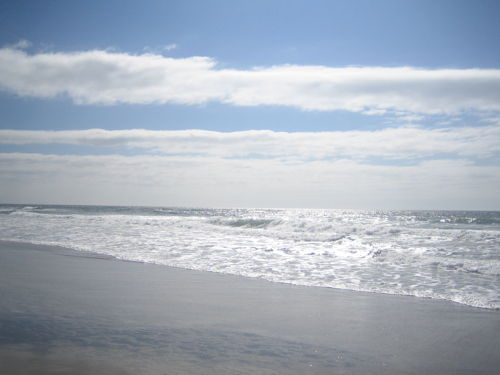I was a strict vegetarian for twenty years. Then someone offered me a scallop.
That plump, muscly perfect circle, geometrically a marvel, a white coin jetting hot juice: Oh glorious bivalve, cookie-of-the-sea, you gave your life for me!
Scallops are not just seafood. Their shells were powerful symbols in the art and religion of the Mayas, Aztecs and other pre-Columbian cultures. The ancient Roman goddess Venus is commonly depicted being born from a scallop shell. In early Christianity, scallop shells were inextricably linked with Saint James; it was said that the apostle carried one wherever he went, using it as a begging bowl and eating whatever well-wishers placed inside it. If the spirituality doesn't astound you, the biology will: Unlike any other bivalve, scallops swim. A single scallop can have 100 blue eyes. Please, Lord, let me eat more.
Last week, I was at the casually elegant waterside Monterey Plaza Hotel and Spa, whose restaurant, Schooners, is renowned for its sustainable seafood. This is thanks in part to the nearby Monterey Bay Aquarium, whose Seafood Watch program offers constantly updated data ranking the relative safety and sustainability of thousands of species. At a reception, I spotted those much-craved circles and to my paroxysmal delight was served tender-sweet, smoky seared scallops atop creamy curried corn, as depicted below.
Monterey Plaza executive chef James Waller buys only scallops that have been dry-packed -- that is, shucked and shipped on ice, chemical-free.

At another reception the next day in the same hotel, I nibbled scallops off wooden skewers. Not only was my balcony perched directly over the historic bay. Not only were the hot tubs in full view of seals and otters at play. But also scallops, scallops everywhere.
As always happens while wolfing these babies, I wondered: Why aren't scallops more popular than oysters, shrimp and clams? Why do other molluscs -- not to mention crustaceans -- get all the attention?
Price has a lot to do with that. Scallops are less plentiful than those other creatures in the wild, and far less commonly farmed. Although the spendiest, most sustainable scallops are hand-plucked by SCUBA divers off the sea floor, "the majority of wild scallops are caught using a fishing gear called a New Bedford dredge, which is a fifteen-foot-wide steel frame that is used to drag a chain bag along the seafloor," explains conservationist Gib Brogan, Northeast representative of the nonprofit Oceana. Having spent nearly a decade striving to reform the Atlantic scallop fishery, whose 300-plus boats now catch over $500 million worth of scallops every year, Brogan doesn't love the New Bedford dredge:
"The frame suspends the scallops in the water, where they are caught in the bag. This gear has significant impacts on the sea floor and results in significant catch of species other than scallops including flounder, monkfish and skates. The gear has a history of catching threatened and endangered sea turtles, but will be required to be modified in the near future to reduce turtle catch."
Scallop farming -- common in Asia, but still only experimental in US waters -- presents a far safer, more affordable alternative. The Monterey Bay Aquarium's Seafood Watch gives farmed scallops its top rating -- higher even than that of most diver-caught scallops. And while shrimp farming is notoriously unsustainable, scallop farming is a totally different story, says ecologist Carl Safina, founder of the Blue Ocean Institute:
"It's pretty simple: When you farm shrimp, you have to clear out wetland areas to create the farms. Then you have shrimp crowded together at an unnatural density. This results in total destruction of those wetlands."
Shrimps have to be fed.
"But bivalves -- clams, oysters, scallops -- make a living by filtering their food out of the water. If anything, while being farmed they would go back to performing their natural environmental service of filtering, which lets more light into the water for sea-floor plants and can bring an area back closer to the way it's supposed to be. A shrimp farm is a very unnatural place, but a scallop farm is a remarkably natural place," Safina told me while preparing to cook -- on a wood-burning stove -- scallops he had hand-harvested himself and stored in his freezer, which lost power along with the rest of his Long Island house during Hurricane Sandy.
Raising the number of American scallop farms could boost the economy, provide jobs, and lower the price of this master mollusc.
But be warned: Most commercially harvested scallops are soaked in sodium tripolyphosphate, aka STP or STPP: an inorganic compound commonly used in detergents, ceramics, flame retardants -- and seafood, which it helps to retain water. STP can bloat scallops, making them artificially heavy and wet.
Chef Waller, who uses only chemical-free scallops, described what happened when he first saw the Seafood Watch charts and realized what following their advice might mean in his kitchens at the Monterey Plaza:
"I thought: You're crazy! This is going to cost a fortune! But then I realized -- it's about sustainability but it's not just about sustainability. It's also about quality."
He shared with me one of his favorite scallop recipes. All hail the blesséd bivalve.
Monterey Plaza Seared Scallops
5 scallops
1 cup pea tendrils
1 cup curried corn sauce
1/4 Meyer lemon
4 T whole butter
3 T chopped herbs
salt and pepper to taste
1/4 cup whole corn kernels
In a sauté pan, sear scallops until caramelized. Sauté pea tendrils in butter. Heat corn kernels. Add curried corn sauce and lemon. Finish with butter and herbs.
Scallop images photographed by Kristan Lawson. Beach image photographed by Anneli Rufus. All images used with permission.

